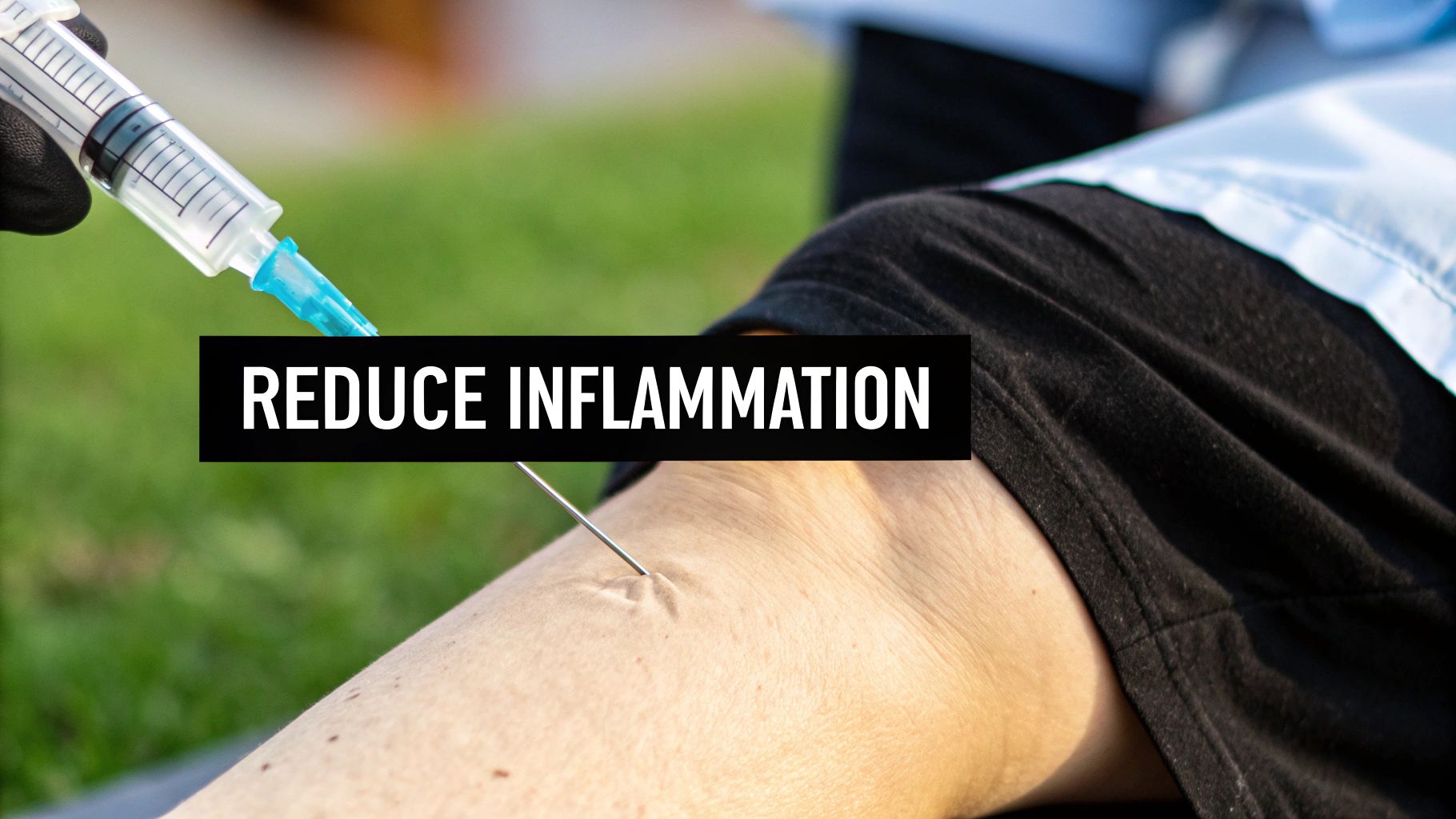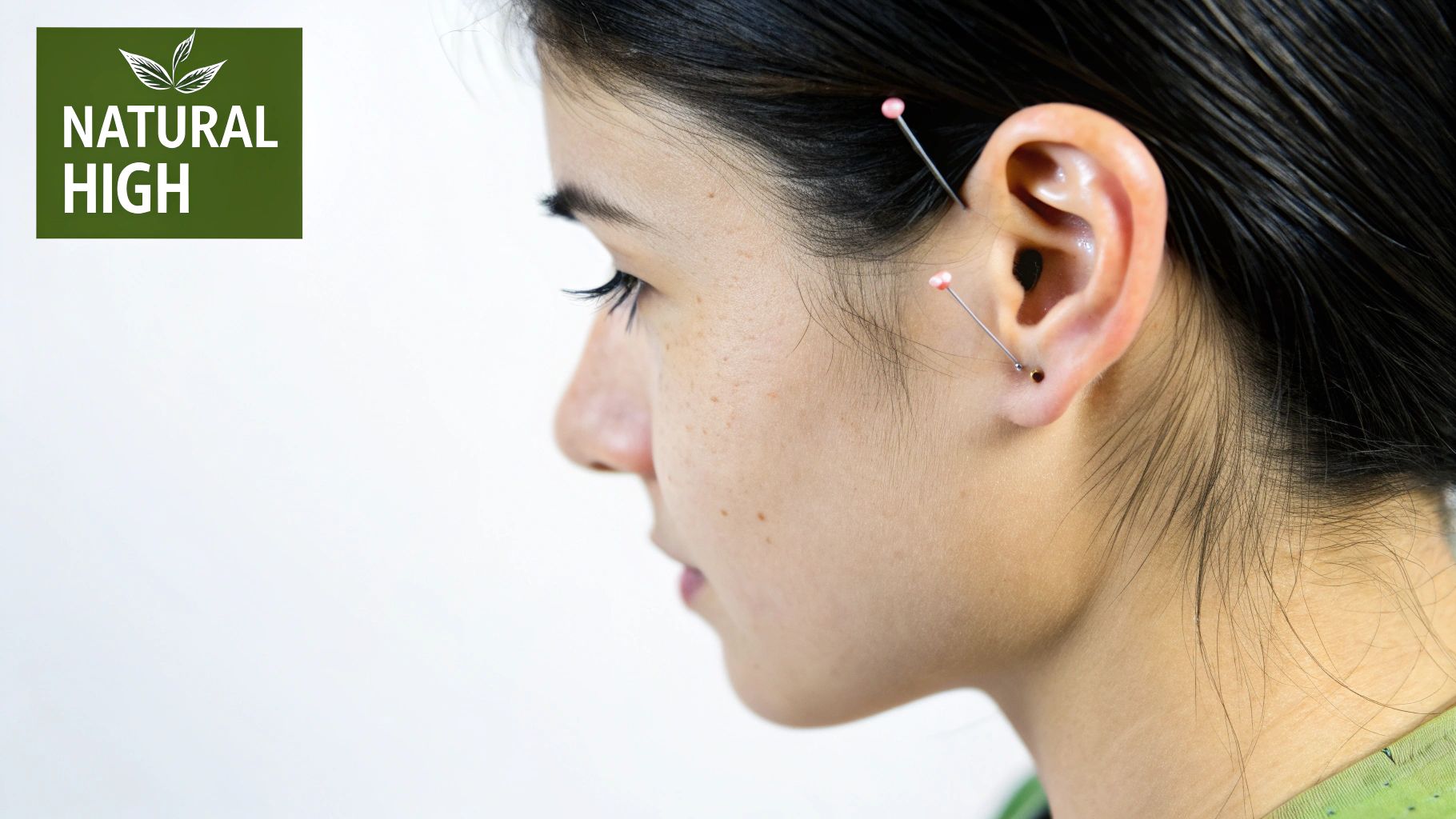When persistent pain disrupts your life, finding effective and sustainable relief becomes a priority. For individuals seeking alternatives to conventional pharmaceuticals, acupuncture presents a time-tested, holistic approach to managing discomfort. This article delves into the specific, evidence-backed benefits of acupuncture for pain, moving beyond generalities to offer a clear roadmap of what you can expect from this traditional therapy.
We will explore how acupuncture provides more than just temporary relief. You will learn precisely how it works to manage chronic conditions, reduce systemic inflammation, and trigger the release of your body’s natural painkillers. We will also examine its direct impact on muscle tension, its role in improving sleep for better recovery, and how it enhances blood circulation to promote healing at the source of your pain.
This comprehensive guide is designed for those in areas like Chino, CA, exploring integrative health solutions for conditions ranging from back pain and arthritis to stress-induced tension. By understanding these key mechanisms, you can make an informed decision about incorporating acupuncture into your personalized wellness plan. Each section will provide actionable insights, helping you understand not just the what but the how behind acupuncture's powerful analgesic effects.
1. Chronic Pain Management
One of the most significant and well-documented benefits of acupuncture for pain is its remarkable efficacy in managing chronic conditions. For individuals living with persistent pain from issues like osteoarthritis, fibromyalgia, or lower back pain, acupuncture offers a powerful, non-pharmacological alternative. It works by stimulating specific points on the body, which prompts the nervous system to release endorphins, the body's natural painkillers. This process also helps modulate pain signaling pathways, reducing the brain's perception of discomfort over time.

Unlike acute pain treatments that may offer only temporary relief, acupuncture for chronic pain aims to create lasting change in how your body processes and responds to pain signals. This approach has gained significant traction in mainstream medicine, with endorsements from the World Health Organization and the National Institutes of Health.
Successful Implementation in Modern Healthcare
The integration of acupuncture into conventional medical settings highlights its proven value. For instance, many Veterans Affairs (VA) hospitals now offer acupuncture as a standard option for managing chronic pain among veterans, reducing reliance on opioids. Similarly, renowned institutions like the Mayo Clinic include acupuncture in their integrative pain programs, combining it with physical therapy and conventional medicine for a comprehensive approach. Cancer treatment centers also utilize acupuncture to alleviate chemotherapy-induced peripheral neuropathy, a painful side effect that often resists other treatments.
Key Insight: Acupuncture doesn't just mask pain; it influences the underlying neurochemical mechanisms that sustain chronic pain cycles, offering a path toward genuine, long-term relief.
Actionable Steps for Patients
If you are considering acupuncture for a persistent pain condition, a structured approach will yield the best results.
- Commit to a Treatment Plan: Chronic conditions typically require more than a single session. Plan for an initial course of 8-12 treatments to allow the cumulative effects to build.
- Track Your Progress: Keep a detailed pain diary. Note your pain levels, frequency, and duration, along with any changes in your mobility or mood. This data helps your practitioner tailor the treatment.
- Adopt a Holistic View: Combine your acupuncture sessions with gentle activities like walking or stretching and stress-reduction techniques such as mindfulness or deep breathing to enhance the benefits.
- Choose a Certified Practitioner: Ensure your acupuncturist is certified by a reputable body like the National Certification Commission for Acupuncture and Oriental Medicine (NCCAOM).
To explore this topic further, you can learn more about acupuncture for chronic pain management and see how it can be integrated into a personalized wellness plan.
2. Reduced Inflammation Response
Beyond simply managing pain symptoms, one of the core benefits of acupuncture for pain is its ability to actively reduce inflammation at a cellular level. Chronic pain is often fueled by a persistent inflammatory state, where the body's immune response becomes overactive. Acupuncture intervenes by modulating key biochemical pathways, which helps downregulate the production of pro-inflammatory cytokines and other inflammatory markers that cause swelling, heat, and pain. This makes it a powerful tool for conditions where inflammation is the primary driver, such as rheumatoid arthritis or athletic injuries.

This anti-inflammatory effect is achieved by stimulating specific acupoints that influence the nervous system and endocrine glands. This stimulation can trigger the release of substances like adenosine, which has potent anti-inflammatory properties, and regulate the hypothalamic-pituitary-adrenal (HPA) axis, the body's central stress and inflammation control system. Research from institutions like Harvard Medical School has validated these mechanisms, showing how acupuncture can create measurable changes in the body’s inflammatory environment.
Successful Implementation in Modern Healthcare
The anti-inflammatory properties of acupuncture are being leveraged across various medical fields. For example, sports medicine clinics frequently recommend acupuncture to professional athletes to accelerate recovery from sprains and strains, reducing downtime by controlling post-injury inflammation. In rheumatology, patients with arthritis often report reduced joint swelling and stiffness, which is sometimes corroborated by lower levels of inflammatory markers in blood tests. Furthermore, leading institutions like Memorial Sloan Kettering Cancer Center incorporate acupuncture to manage inflammatory pain conditions in patients, and those with fibromyalgia often experience a decrease in tender point sensitivity due to its systemic anti-inflammatory effects.
Key Insight: Acupuncture offers more than symptomatic relief; it directly targets and helps resolve the underlying inflammation that perpetuates many chronic pain conditions, addressing the problem at its source.
Actionable Steps for Patients
To maximize the anti-inflammatory benefits of acupuncture, a proactive and strategic approach is essential.
- Schedule During Flares: Consider scheduling treatments during active inflammatory flare-ups, as acupuncture can be particularly effective at calming an acute response.
- Combine with Diet: Enhance the effects by adopting an anti-inflammatory diet. Focus on whole foods, leafy greens, and omega-3 fatty acids while avoiding processed foods, sugar, and alcohol.
- Monitor Progress: For conditions like rheumatoid arthritis, work with your medical doctor to monitor inflammatory markers (like C-reactive protein) through blood tests to objectively track your progress.
- Stay Consistent: Inflammation reduction is a cumulative process. Stick to the treatment plan recommended by your licensed acupuncturist for sustained results.
To dive deeper into this subject, you can explore more about alternative medicine options for pain reduction and how they can be part of a comprehensive health strategy.
3. Natural Endorphin Release
One of the core biochemical benefits of acupuncture for pain is its ability to trigger the release of the body's own powerful pain-relieving chemicals. When fine needles stimulate specific acupuncture points, they send signals through the nervous system to the brain, prompting the release of endorphins, enkephalins, and other opioid peptides. These neurochemicals function similarly to opioid medications by binding to opioid receptors in the brain, effectively blocking pain signals and inducing a sense of well-being, but without the risk of addiction.

This natural analgesic effect is central to why acupuncture provides such profound relief for both acute and chronic pain. The groundbreaking research by Dr. Bruce Pomeranz in the 1970s was among the first to scientifically validate this mechanism, demonstrating that acupuncture’s pain-relieving effects could be blocked by naloxone, a drug that reverses opioid effects. This proved that the body’s endogenous opioid system was directly involved.
Successful Implementation in Modern Healthcare
Harnessing this natural endorphin response has led to innovative applications of acupuncture in demanding medical environments. For instance, the National Acupuncture Detoxification Association (NADA) protocol uses specific ear acupuncture points to help manage withdrawal symptoms and cravings in addiction treatment centers, relying heavily on the calming and pain-dulling effects of endorphin release. Furthermore, hospitals are increasingly implementing acupuncture for post-surgical pain management, which helps lower the need for prescription opioids and accelerates recovery. Dr. Richard Niemtzow’s development of "battlefield acupuncture," a protocol using tiny needles in the ear, provides rapid pain relief for soldiers in active-duty settings where traditional painkillers are impractical.
Key Insight: Acupuncture leverages your body's innate pharmacy, activating a safe, self-regulating system of pain relief that avoids the dependency and side effects associated with external medications.
Actionable Steps for Patients
To maximize the neurochemical benefits of your acupuncture treatment, consider these practical steps.
- Schedule Rest Time: Plan your sessions for a time when you can relax afterward. The endorphin release can create a feeling of deep relaxation or mild euphoria, and resting allows your body to fully integrate these effects.
- Stay Hydrated: Proper hydration is essential for all neurochemical processes. Drink plenty of water before and after your appointment to support your body's ability to produce and circulate endorphins.
- Practice Deep Breathing: Focus on slow, deep breaths, especially during needle insertion. This calms the nervous system and can enhance the endorphin-releasing effect of the treatment.
- Avoid Intense Activities: Refrain from scheduling strenuous exercise or high-stakes meetings immediately after your session. Allow the calming effects to settle in without interruption.
You can find out more about how our approach can help by exploring the conditions we treat, including various forms of pain that respond well to endorphin modulation.
4. Muscle Tension and Spasm Relief
Acupuncture provides powerful and direct relief for muscle tension and spasms, making it a cornerstone therapy for musculoskeletal pain. By precisely targeting trigger points, which are hyper-irritable knots in muscle tissue, and motor points, where nerves enter the muscle, the insertion of a fine needle can elicit a "twitch response." This involuntary contraction is followed by immediate relaxation of the muscle fiber, effectively breaking the pain-spasm-pain cycle that perpetuates discomfort. This process also significantly improves local blood circulation, flushing out inflammatory substances and delivering oxygen-rich blood to promote healing.

This targeted approach allows practitioners to address the root cause of muscle pain, rather than just its symptoms. The work of pioneers like Dr. Janet Travell on trigger points and modern experts like Jan Dommerholt on dry needling (a technique often used by acupuncturists) has validated this mechanical and neurological basis for relief.
Successful Implementation in Modern Healthcare
The effectiveness of acupuncture for muscle release is widely recognized across various healthcare disciplines. Many physical therapy clinics now integrate dry needling, a technique rooted in acupuncture principles, to treat myofascial pain and improve range of motion. Sports medicine practices frequently use acupuncture to treat acute muscle strains and chronic overuse injuries in athletes, accelerating their return to play. Furthermore, occupational therapy programs recommend acupuncture for patients with repetitive strain injuries from desk work or manual labor, as it effectively releases tension in the neck, shoulders, and forearms.
Key Insight: Acupuncture directly interrupts the feedback loop between muscle tightness and pain signals, offering a mechanical release that allows the muscle to reset and heal.
Actionable Steps for Patients
To maximize the benefits of acupuncture for muscle-related pain, patients can take several proactive steps.
- Communicate During Treatment: Let your practitioner know what you are feeling. Sensations like a dull ache, a twitch, or a feeling of release are important feedback that helps guide the treatment.
- Apply Gentle Heat: Using a heating pad or taking a warm bath after your session can enhance muscle relaxation and maintain the benefits of the treatment.
- Incorporate Gentle Stretching: Within 24 hours of your appointment, perform gentle stretches for the treated area to improve flexibility and prevent the muscle from tightening again.
- Avoid Strenuous Activity: Give your body time to integrate the treatment. Avoid intense workouts or heavy lifting for at least 24 hours post-treatment.
For a deeper look into how this works, you can learn more about acupuncture for muscle tension and how it can be a vital part of your pain management strategy.
5. Improved Sleep Quality and Pain Recovery
A critical, yet often overlooked, benefit of acupuncture for pain is its profound impact on sleep quality. The relationship between pain and sleep is a vicious cycle: chronic pain disrupts sleep, and poor sleep lowers the pain threshold, making the discomfort feel more intense. Acupuncture helps break this cycle by addressing both issues simultaneously, promoting deep, restorative sleep that is essential for the body's natural healing and recovery processes. It achieves this by calming the sympathetic nervous system (our "fight or flight" response) and boosting the production of serotonin and melatonin, hormones that regulate sleep.
This dual-action approach is particularly valuable for individuals whose chronic pain is exacerbated by insomnia. By fostering better sleep, acupuncture not only provides direct pain relief but also enhances physical repair, reduces inflammation, and improves overall mood and resilience. This comprehensive effect underscores how acupuncture treats the whole person, not just isolated symptoms.
Successful Implementation in Modern Healthcare
The effectiveness of acupuncture in managing sleep disturbances is increasingly recognized in specialized medical fields. For example, leading insomnia clinics, guided by research from pioneers like Dr. Rachel Manber at Stanford Sleep Medicine, now incorporate acupuncture into their treatment protocols. These programs find that it helps patients fall asleep faster and stay asleep longer, often reducing the need for sleep medications.
Similarly, comprehensive cancer centers utilize acupuncture to mitigate treatment-related side effects, including pain and insomnia, which are common in oncology patients. It is also a core component of many integrative pain management programs, which recognize that addressing the sleep-pain cycle is fundamental to achieving long-term recovery and improving a patient's quality of life.
Key Insight: Acupuncture doesn't just treat pain or insomnia separately; it rebalances the neurochemical and hormonal systems that connect them, interrupting the negative feedback loop that keeps patients in a state of discomfort and fatigue.
Actionable Steps for Patients
To leverage acupuncture for better sleep and pain recovery, consider these targeted actions.
- Time Your Treatments: Schedule your acupuncture sessions in the late afternoon or early evening. This can enhance its sedative effects and help you wind down for a more restful night.
- Maintain Sleep Hygiene: Complement your treatments by adhering to a strict sleep schedule, even on weekends. Create a relaxing bedtime routine to signal to your body that it's time to sleep.
- Keep a Sleep and Pain Diary: Track the quality and duration of your sleep alongside your daily pain levels. This information will help your acupuncturist fine-tune the treatment for maximum benefit.
- Optimize Your Sleep Environment: Ensure your bedroom is dark, quiet, and cool. Avoid caffeine and stimulating screen time for at least an hour before bed to support your body's natural sleep cycle.
6. Enhanced Blood Circulation and Healing
A fundamental benefit of acupuncture for pain relief lies in its ability to significantly improve blood circulation. By stimulating specific acupoints, acupuncture triggers local vasodilation, which is the widening of blood vessels. This process increases blood flow to injured or painful areas, delivering a rich supply of oxygen, nutrients, and immune cells essential for tissue repair while simultaneously flushing out metabolic waste products and inflammatory substances that contribute to pain.
This physiological response is not just a localized effect; it supports the body's entire healing cascade. Improved microcirculation means that damaged muscles, ligaments, and nerves receive the resources they need to regenerate more efficiently, which shortens recovery time and reduces the duration and intensity of pain. Research, including studies in publications like the American Journal of Physiology, has validated this mechanism, moving it from traditional theory to evidence-based science.
Successful Implementation in Modern Healthcare
The application of acupuncture to boost circulation is evident across various medical fields. In sports medicine clinics, it is a go-to therapy for accelerating recovery from sprains, strains, and other athletic injuries. Rehabilitation facilities incorporate acupuncture to improve motor function and sensation in stroke survivors by enhancing blood flow to affected areas of the brain and limbs. Furthermore, specialized wound care centers are now using acupuncture to treat conditions like diabetic ulcers, where poor circulation is a primary barrier to healing.
Key Insight: Acupuncture acts as a catalyst for your body's innate healing abilities by ensuring that the building blocks for repair are delivered directly to where they are needed most, addressing a root cause of persistent pain and slow recovery.
Actionable Steps for Patients
To maximize the circulatory benefits of your acupuncture treatments, consider these practical steps.
- Stay Well-Hydrated: Drink plenty of water before and after your sessions. Proper hydration supports healthy blood volume and flow, amplifying the treatment's effects.
- Engage in Gentle Movement: After your appointment, light activities like walking or gentle stretching can help maintain the increased circulation achieved during the session.
- Avoid Tight Clothing: Wear loose, comfortable clothing to and from your appointment to ensure blood can flow freely to the treated areas without restriction.
- Choose a Certified Practitioner: A skilled practitioner knows the precise points to stimulate for circulatory enhancement. Ensure they are certified, for example, by the National Certification Commission for Acupuncture and Oriental Medicine (NCCAOM).
To learn more about how this benefit can aid your recovery, you can explore information on acupuncture for sports injuries and pain, where targeted treatment can make a significant difference.
Benefits Comparison of Acupuncture Pain Relief
| Aspect | Chronic Pain Management | Reduced Inflammation Response | Natural Endorphin Release | Muscle Tension and Spasm Relief | Improved Sleep Quality and Pain Recovery | Enhanced Blood Circulation and Healing |
|---|---|---|---|---|---|---|
| Implementation Complexity 🔄 | Moderate – requires multiple sessions | Moderate – timed with flares | Low to Moderate – frequent sessions | Moderate – requires skilled practitioner | Moderate – consistent scheduling needed | Moderate – ongoing treatments advised |
| Resource Requirements ⚡ | Medium – certified practitioners, multiple visits | Medium – blood tests and diet adjustments | Low – rest after treatments | Medium – skilled needling, follow-up care | Medium – timing and lifestyle adjustments | Medium – hydration and monitoring needed |
| Expected Outcomes 📊 | Sustained pain relief weeks/months | Reduced inflammatory markers, systemic benefits | Natural pain relief, mood elevation | Immediate muscle relaxation, pain break | Better sleep, reduced pain perception | Accelerated healing, reduced swelling |
| Ideal Use Cases 💡 | Chronic pain resistant to meds | Inflammatory pain conditions | Pain with mood/anxiety components | Muscle spasms, trigger points | Pain-related insomnia and recovery cycles | Tissue healing, injury and edema recovery |
| Key Advantages ⭐ | Non-drug, targets pain pathways | Natural alternative to NSAIDs/steroids | No addiction risk, mood boost | Rapid relief, synergizes with PT | Non-habit forming, improves energy | Boosts circulation, detoxification |
Final Thoughts
Throughout this guide, we have journeyed through the multifaceted ways acupuncture serves as a powerful ally against pain. We've moved beyond a surface-level understanding to see how this ancient practice offers a sophisticated, holistic, and scientifically supported approach to healing. The core takeaway is that the benefits of acupuncture for pain are not isolated; they are interconnected, creating a synergistic effect that promotes whole-body wellness.
We explored how acupuncture provides durable chronic pain management, offering a sustainable alternative to long-term medication for conditions like arthritis and back pain. We delved into its ability to modulate the body’s inflammatory response at a cellular level, addressing the root cause of much discomfort. Furthermore, we highlighted its profound impact on the nervous system, triggering a natural release of endorphins that act as the body’s own potent analgesics.
Integrating Acupuncture into Your Wellness Strategy
Understanding these benefits is the first step; integrating them into your life is the next. For those dealing with persistent knots and stiffness, the targeted relief of muscle tension and spasms can be transformative. For individuals whose pain disrupts rest, the improvement in sleep quality facilitated by acupuncture creates a positive feedback loop, where better sleep enhances the body's natural recovery processes. Finally, the crucial role of enhanced blood circulation underscores how acupuncture doesn't just mask pain, it actively supports the delivery of oxygen and nutrients to damaged tissues, accelerating healing from within.
The true value of embracing acupuncture lies in its personalized nature. It is not a one-size-fits-all remedy but a dynamic therapy that adapts to your unique constitution and health concerns.
Key Insight: Acupuncture treats the person, not just the symptom. It rebalances the body's systems, empowering it to manage pain and heal itself more effectively, leading to lasting relief and improved quality of life.
Your Path Forward to a Pain-Managed Life
Taking action requires a commitment to exploring a new paradigm of health, one that views pain as a signal from the body that something is out of balance. Your path forward involves seeking a qualified, experienced practitioner who can translate your specific symptoms into a tailored treatment plan. Consider these actionable steps:
- Consult a Professional: Schedule a consultation to discuss your specific pain points, health history, and wellness goals.
- Embrace Consistency: Understand that acupuncture often yields the best results with a series of treatments. Consistency is key to re-educating your body's pain and healing responses.
- Stay Open-Minded: Allow the therapy to work. Many patients report not only a reduction in their primary pain complaint but also unexpected benefits like reduced stress and increased energy.
By harnessing the profound benefits of acupuncture for pain, you are not just alleviating discomfort. You are investing in a more balanced, resilient, and vibrant version of yourself, equipped with a powerful tool for long-term health and well-being.
Ready to experience these benefits firsthand and start your personalized healing journey? At Eric Tsai Acupuncture and Herbs, we specialize in creating customized treatment plans that address the root cause of your pain. Schedule your consultation with us today and take the first step toward lasting relief and restored vitality.

